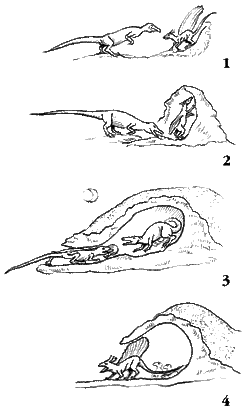
The bright colors of the male dingum's crest and sail warn would-be larger predators of his poisonous nature.
The dingum, Velludorsum venenum, is an omnivorous, partly quadrupedal maniraptoran with great sexual dimorphism, from the deserts and desert scrubs of the Outback, in The New Dinosaurs: An Alternative Evolution.
Like a big lizard, a male dingum creeps through the grasses of the hot, central Australian plains of the Outback, hunting small mammals (australodelphian marsupials, monotremes and few placental mammals), reptiles and insects in the dry tussocks. Suddenly a dark shadow sweeps across as a hunting pterodactyl pterosaur hurtles down from the sky. In an immediate reaction, the dingum arches his back and dips his head. A fin of skin supported by struts of bone springs up from his curved back and presents a gaudily-colored sail to the attacker, a sudden burst of garish color against the drab grasses. The crest on the back of the head pops up a frill of spines, each one poisonous enough to kill a large attacker. The pterosaur breaks off its attack, instinctively knowing that these colors mean danger and death, and flies away to seek easier prey.
The dingum measures only about a meter (3 feet) long. It is descended from Kakuru (making it closely related to the cribrum and the pouch) and, like many other Australasian animals, lives nowhere else in the world. It is a primary meat-eater but occasionally eats small poisonous plants. The dingum itself is immune to the poison which is then concentrated in the spines at the back of a male's head and used in defense. The female is quite a different animal, however, having neither poison spines nor a sail. She is much larger than the male and has a more conventional coelurosaur shape. She is more secretive in her habits, avoiding other predators by not being conspicuous.

The dingum's complex mating and nesting ritual begins during the wet season. The male begins to build his nest from clay and the half-built nest is used as a display arena while he courts a female (1). After mating the couple continue to build (2). By the dry season, the nest is completed, with the female walled up inside incubating the eggs while the male hunts for food (3). In the next wet season when the eggs have hatched, the male stands guard at a newly enlarged nest entrance while the female hunts (4).
